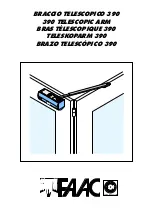
Tungsten Electrodes
• Tungsten is a rare metallic element used for manufacturing TIG welding electrodes. The TIG process relies
on tungsten’s hardness and high-temperature resistance to carry the welding current to the arc. Tungsten
has the highest melting point of any metal, 3,410 degrees Celsius.
• Tungsten electrodes are non-consumable and come in a variety of sizes; they are made from pure tungsten
or an alloy of tungsten and other rare earth elements. Choosing the correct tungsten depends on the
material being welded, the number of amps required and whether you are using AC or DC welding current.
• Tungsten electrodes are colour-coded at the end for easy identification.
• Below are the most commonly used tungsten electrodes found in the New Zealand and Australian market.
Thoriated
Thoriated tungsten electrodes (AWS classification EWTh-2) contain a minimum of 97.30 per cent tungsten
and 1.70 to 2.20 per cent thorium and are called 2 per cent thoriated. They are the most commonly used
electrodes today and are preferred for their longevity and ease of use. Thorium, however, is a low-level
radioactive hazard and many users have switched to other alternatives. Regarding the radioactivity, thorium
is an alpha emitter, but when it is enclosed in a tungsten matrix, the risks are negligible. Thoriated tungsten
should not get in contact with open cuts or wounds. The more significant danger to welders can occur when
thorium oxide gets into the lungs. This can happen from the exposure to vapours during welding or ingestion
of material/dust in the grinding of the tungsten. Follow the manufacturer’s warnings, instructions, and the
Material Safety Data Sheet (MSDS) for its use.
T3 (Colour Code: Purple)
T3 tungsten electrodes (AWS classification EWG) contain a minimum of 98% per cent tungsten and up to
1.5 per cent Lanthanum and small percentages of Zirconium and Yttrium they are called T3 tungsten. T3
Tungsten Electrodes provide conductivity similar to that of thoriated electrodes. Typically, this means that
T3 Tungsten Electrodes are exchangeable with thoriated electrodes without requiring significant welding
process changes. T3 delivers superior arc starting, electrode lifetime, and overall cost-effectiveness. When
T3 Tungsten Electrodes are compared with 2% thoriated tungsten, T3 requires fewer re-grinds and provides
a longer overall lifetime. Tests have shown that ignition delay with T3 Tungsten Electrodes improve over
time, while 2% thoriated tungsten starts to deteriorate after only 25 starts. At equivalent energy output, T3
Tungsten Electrodes run cooler than 2% thoriated tungsten, thereby extending overall tip lifetime. T3 Tungsten
Electrodes work well on AC or DC. They can be used DC electrode positive or negative with a pointed end, or
balled for use with AC power sources.
Ceriated (Colour Code: Orange)
Ceriated tungsten electrodes (AWS classification EWCe-2) contain a minimum of 97.30 per cent tungsten and
1.80 to 2.20 per cent cerium and are referred to as 2 per cent ceriated. Ceriated tungstens perform best in DC
welding at low current settings. They have excellent arc starts at low amperages and become popular in such
applications as orbital tube welding, thin sheet metal work. They are best used to weld carbon steel, stainless
steel, nickel alloys, and titanium, and in some cases, it can replace 2 per cent thoriated electrodes. Ceriated
tungsten is best suited for lower amperages it should last longer than Thoriated tungsten higher amperage
applications are best left to Thoriated or Lanthanated tungsten.
Lanthanated (Colour Code: Gold)
Lanthanated tungsten electrodes (AWS classification EWLa-1.5) contain a minimum of 97.80 per cent tungsten
and 1.30 per cent to 1.70 per cent lanthanum and are known as 1.5 per cent lanthanated. These electrodes
have excellent arc starting, a low burn-off rate, good arc stability, and excellent re-ignition characteristics.
Lanthanated tungstens also share the conductivity characteristics of 2 per cent thoriated tungsten.
Lanthanated tungsten electrodes are ideal if you want to optimise your welding capabilities. They work well
on AC or DC electrode negative with a pointed end, or they can be balled for use with AC sine wave power
sources. Lanthanated tungsten maintains a sharpened point well, which is an advantage for welding steel and
stainless steel on DC or AC from square wave power sources.
Zirconiated (Colour Code: White)
Zirconiated tungsten electrodes (AWS classification EWZr-1) contain a minimum of 99.10 per cent tungsten and
0.15 to 0.40 per cent zirconium. Most commonly used for AC welding Zirconiated tungsten produces a very
stable arc and is resistant to tungsten spitting. It is ideal for AC welding because it retains a balled tip and has
a high resistance to contamination. Its current-carrying capacity is equal to or greater than that of thoriated
tungsten. Zirconiated tungsten is not recommended for DC welding.
TIG WELDING GUIDE
29
Summary of Contents for RAZOR 320 AC/DC
Page 1: ...RAZOR 320 AC DC KUMJRRW320ACDC Operating Manual...
Page 2: ...2...
Page 45: ...NOTES 45...
Page 46: ...NOTES 46...
Page 47: ...NOTES 47...
















































